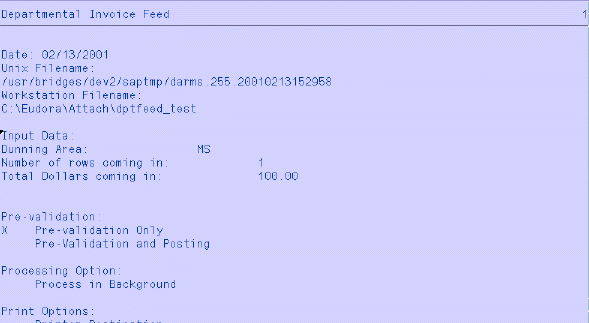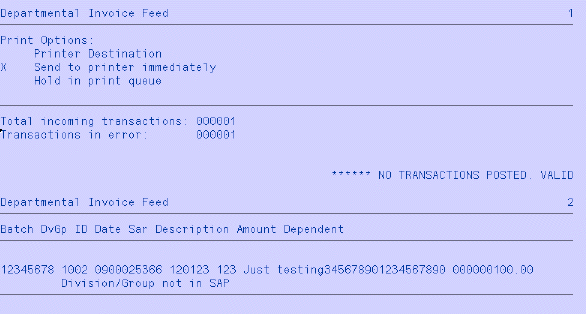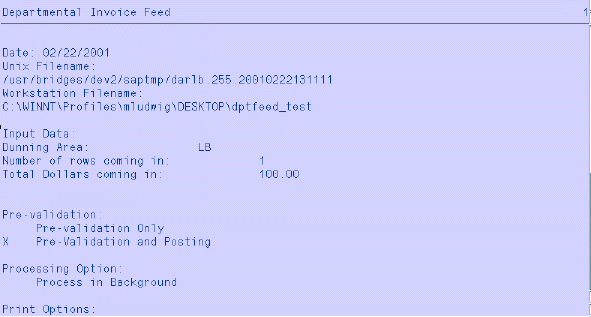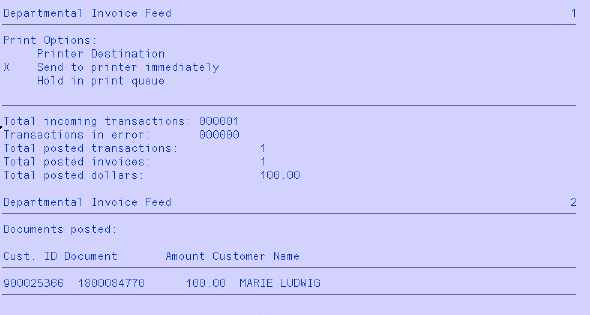

Your text file of invoice data must consist of the fields (and fixed field lengths) described below. You can create it in another application, for example Excel, and then "Save as.." a formatted text file, for example Formatted Text (Space Delimited).
| Field name | Length (Start - End) | Description |
|---|---|---|
| Batch | 8 (1-8) | batch number; any 8 characters |
| Dv | 2 (9-10) | division (10-41) |
| Gp | 2 (11-12) | group Note: Division and group together determine dunning area. |
| ID | 10 (13-22) | customer ID |
| Date | 6 (23-28) | service date; mmyydd; used in SAP description |
| Transaction (or Sar) code | 3 (29-31) | Used to determine what G/L account (legacy system: object code) or cost center/internal order (legacy system: account) to credit |
| Description | 30 (32-61) | description of services |
| Amount | 12 (62-73) | transaction amount |
| Dependent | 20 (74-93) | Medical enters dependent name; library enters book call number.
Note: Concatenated with Description to get SAP's transaction text. |
 Note: This feed procedure will not
work unless you set Decimal Notation to Period using System =>
User Profile => Own Data => Defaults tab. After resetting Decimal Notation,
you need to logoff SAP and then login again.
Note: This feed procedure will not
work unless you set Decimal Notation to Period using System =>
User Profile => Own Data => Defaults tab. After resetting Decimal Notation,
you need to logoff SAP and then login again.

Dunning Area
(Enter 2-character code for dunning area)
Number of rows coming in
(Enter number of invoice records; batch record total)
Total dollars coming in
(Enter total invoice dollars = batch dollar total; use comma instead of decimal point)
The first time through you should select Prevalidation only (see below).

The first time through you may want to turn background processing off (see below).
![]()
With background processing off, the report goes to your screen. With background processing on, the report goes to your printer. (The default is "yes" for background processing on/report to printer.)
Result: A window opens so that you can locate the text file
to validate (see below). 
 Note: If the number of records or
dollars in the text file being validated does NOT match your input data,
an error message displays (see below). You need to repeat step
3, this time entering the batch totals correctly.
Note: If the number of records or
dollars in the text file being validated does NOT match your input data,
an error message displays (see below). You need to repeat step
3, this time entering the batch totals correctly.


The report body lists any errors that were found, as shown below.

| Error message | What to do |
|---|---|
| Customer ID not in Customer Master | Check the data in the customer ID field. You may need to use FD01 - Create customer master record |
| Amount contains non-numeric data | Check the data in the amount field. |
|
(SAP does not create Library invoices for less than $5.00) |
|
Call Maria Tantoulos at 3-2758 for assistance. |
| Another message, different from any of the above | Call Maria Tantoulos at 3-2758 or send e-mail to fuller@mit.edu |

Reenter input data, if needed.
This time you should select Prevalidation and Posting (see below).

With background processing off, the report goes to your screen. With background processing on, the report goes to your printer. (The default is "yes" for background processing on/report to printer.)
Note: If you select background processing, you should review and select Print Options (shown below).

Result: A window opens so that you can locate the text file
to validate (see below). 
 Note: A warning message displays
(see below), if the SAME number of records and dollars was loaded previously.
You can cancel the load if the batch was already fed into SAP.
Note: A warning message displays
(see below), if the SAME number of records and dollars was loaded previously.
You can cancel the load if the batch was already fed into SAP.


The report body describes posted transactions and errors, as shown below. For more information about errors, see step 6.
